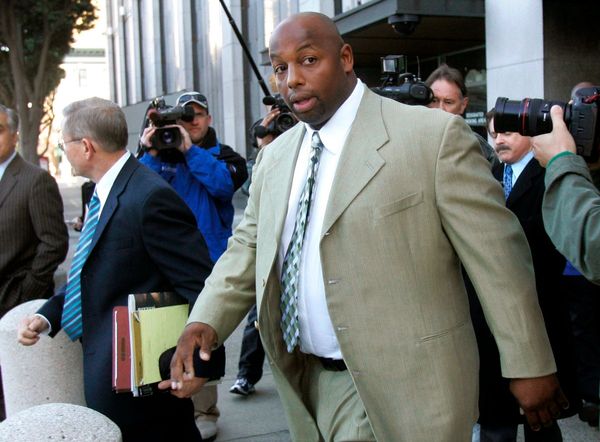
On the screen, a blond boy blows out his first birthday candle. A minute later he is surrounded by his family at his second birthday party, then his third. We see him dressed as Batman, running up and down a sunlit suburban street. Aged six, he imperiously sits down and pretends to read a newspaper in the garden, acting like the man of the house, while his younger sister pretends to iron next to him. As we see him grow up, the effect is similar to Richard Linklater’s Boyhood, but the sudden, tragic ending that we know is coming casts a shadow over the footage.
This is Cobain: Montage of Heck, the much-anticipated documentary about the Nirvana frontman, which stunned audiences at its premiere at the Sundance film festival in January. NME described it as “a revelatory glimpse into the tormented soul behind Nirvana… the most holistic portrait of a rock icon ever created”, and Rolling Stone called it, “the unfiltered Kurt experience… you don’t just feel as if you’ve gotten to know the man better. You’re left completely emotionally spent.”
Twenty-one years after Cobain’s death, this is the first authorised documentary. The project’s genesis is a film-maker’s dream. Brett Morgen was approached by Cobain’s widow, Courtney Love, in 2007 after she saw his documentary about Hollywood producer Robert Evans, The Kid Stays in the Picture, and liked his inventive use of archive footage. She then gave him crates and crates of Cobain’s possessions, and let him do the film he wanted to do. Morgen was given unrestricted access to the archive: 200 hours of audio, 4,000 pages of diaries, home videos, complete editorial freedom and final edit. As a result, the footage in the film consists of 85% unseen and rare material. After the film was finished, Morgen showed it to Love and Cobain’s daughter, Frances, who is listed as executive producer; neither asked for a single edit.
Morgen was a casual fan of the band when he started the project in 2007, but while sifting through and piecing together the material, a different picture of the singer emerged from the one he thought he knew. Instead of the morose and unrelatable rock star he remembered (“this whiny white male who didn’t like fame”, as Morgen put it at Sundance), he encountered a warm and surprisingly funny – yet troubled – man. As the curtains part at the European premiere at the Kino International in Berlin, he says: “I’m happy to reintroduce you to Kurt Cobain.”
The next day, Morgen is sitting in a dimly lit room at the Ritz-Carlton hotel, looking pale and weary. It’s the end of a long day of interviews, and one that has clearly left him emotionally drained. “I don’t think I have got through a Q&A yet without crying,” he says. “There’s something really difficult about finishing this project: I have to let it go now, and of all my subjects – I can’t relate to them the way I can to Kurt. There was a moment two weeks ago when I realised that he wasn’t going to be in my life on a daily basis, and I lost it completely.”
He looks like a man genuinely in the grip of grief. Although he never met Cobain, except for being in the crowd at two half-remembered gigs, over the past eight years he has come to know him intimately, immersing himself in Cobain’s private writings and videos, and getting to know his closest family and friends, who he persuaded to appear in front of the camera. “As I worked on the film, he ceased being a rock star or myth, and became a contemporary, a friend. He became Kim’s brother and Frances’s father and Wendy’s son and Krist’s friend.”
With his scruffy hair, lopsided burgundy tie and gravelly, languid voice, it is easy to guess why Morgen was labelled the “mad scientist” of documentary film by the New York Times. The Oscar-nominated director (for 1999 boxing film On the Ropes) alternates between unwavering eye contact and staring at the floor with a determined kind of intensity. Only a few questions in, his voice starts to break; tears are soon shed. Completing the film was a labour of love: eight years marred by legal struggles and self-doubt, and a staggering amount of material to wade through.
The film is named after a mixtape Cobain made in 1988: an enigmatic 36-minute melange of music ranging from Simon and Garfunkel to the Butthole Surfers, spliced in with bits of radio recordings and early Nirvana demos. “For me, Montage of Heck is like a journey through Kurt’s mind,” says Morgen. “It’s funny, kitschy, romantic, angry, full of contradictory juxtapositions. If you describe the tape, you are, to a certain extent, describing Kurt.”
After Cobain’s death in 1994 at the age of 27, there have been any number of books and films of varying quality about him: Charles Cross’s biography Heavier Than Heaven was thorough but flawed; Michael Azerrad’s interviews with Cobain spawned both a book, Come As You Are, and a documentary, Kurt Cobain: About a Son; Gus van Sant’s fictionalised film Last Days attracted mixed reviews. Nick Broomfield’s 1998 documentary Kurt & Courtney wildly posited that Courtney Love was responsible for Cobain’s death, a claim that conspiracy theorists continue to believe.
None of these films were given rights to use Nirvana’s music, while Montage of Heck heaves with it: from raucous, unseen early live shows to the seminal Reading headline show where Cobain was brought on stage in a wheelchair. But unlike Morgen’s previous documentary, Crossfire Hurricane, about the Rolling Stones, this isn’t primarily a rock doc: the music is almost incidental to the portrait of Cobain the man.
The real achievement of Morgen’s film is its empathetic yet frank portrayal of Cobain: fears, insecurities, flaws and all. It’s a portrait of a man with a troubled childhood, suffering from chronic pain, struggling with drug addiction and depression, eventually succumbing to suicide. “I don’t think I’ve ever seen a portrait of an icon that’s this honest and unflinching and revealing,” Morgen says.
“Part of that has to do with the fact that they gave me final cut, so nothing is watered down, and part of it is that we didn’t want to put Kurt on a pedestal or bring him down, but look him in the eye.” The film doesn’t shy away from showing Cobain in an unflattering light: a review in the Verge says the film “holds nothing back… it will make you hate Cobain at times.”
Throughout, home video footage poignantly shows Cobain at different stages of his life, accompanied by interviews with his family. His parents explain how his early childhood bliss came to an end when they got divorced. In another scene we see him pinging off the walls, the kind of behaviour that led to him being diagnosed with ADHD and prescribed Ritalin. Later footage of his life with Love shows them as a young, happy couple, teasing each other and joking around, instead of the prevailing image of them as a fraught, drug-addicted tragic couple. Most movingly, several scenes show him playing joyfully with his baby daughter, Frances Bean.
Cobain’s extensive diaries are brought to life with Morgen’s kaleidoscopic style: the drawings and scribbles move around and interweave on the screen, turned from a still page into a hallucinogenic cinematic collage by animators Stefan Nadelman and Hisko Hulsing. We are taken into Cobain’s mind through his writing and doodles, ranging from thoughts about music (“a band needs to practise… at least five times a week if the band ever expects to accomplish anything”) to rants against racism and homophobia (in one entry he wishes he was gay because this would rile them further), from potential band names considered before Nirvana (Drugs for Sale, Re-hash) to youthful love letters.
Some of the material Morgen found had never been seen or heard by anyone, including the discovery of 108 audio cassettes, some of them spoken diary entries, that no one knew existed. A few of these are brought to life with animation, filling in the gap where video footage suddenly stops of Cobain’s troubled teenage years, when he was passed around different family members. On one tape Cobain’s own voice describes an early attempt to lose his virginity and the ensuing humiliation in school: he had recorded the tape on his own, put it in a box, and never told anyone about it.
As well as the personal diaries and secret audiotapes, the film includes videos and photos of Cobain and Love in varying states of undress. Was there ever a time when Morgen thought something was too personal to broadcast to the world? “No. Kurt’s mum and sister would have preferred it if certain elements were not there: I completely empathise and understand, but we weren’t making the film for them. Ultimately it’s my version of Kurt based on primary sources. My real responsibility was, I felt, to Kurt.”
The scenes he is talking about are the ones that show the destructive effects of heroin on Cobain: towards the end, the family videos that had been joyful and lively give way to footage that documents the realities of living with addiction. One of the most memorable, and heartbreaking, shows the first haircut of his daughter, Frances. It is a big occasion, and the family gathers round to capture it on camera. But Cobain is distant, a husk. His face is covered in sores, his gaze is empty; the significance of the moment doesn’t get through to him.
Cobain’s sister says in the film that he was embarrassed by his drug use: he didn’t want to be seen as an addict, a junkie. This is something Morgen weighed up, before deciding it was necessary to show the downsides as well as the highs.
At Sundance, still reeling from the acclaim the film received, Morgen was approached by a young woman wearing a Nirvana T-shirt, a recovering addict who had attempted suicide more than once, who told him, “I am never using heroin again”.
“I do feel that Kurt’s heroin use has been slightly romanticised,” Morgen says, “so there’s a moment or two in the film where you see the reality of it. It’s not the point of the film, but I’m optimistic that there will be certain people who see this film and decide that they’ll never touch heroin. And I don’t know a better legacy for Kurt than to save a life.” (Morgen says he himself “partied a lot” as a young man, but never touched heroin having seen the graphic portrayal of heroin withdrawal in Uli Edel’s 1981 film Christiane F).

Most important for Morgen is that Cobain’s daughter, Frances, is happy with the film. When they first met, he recalls: “Before I could get two words out of my mouth Frances started telling me what she thought the film should be, and it was the exact movie that I was about to pitch to her.” Now 22, she was just short of two years old when her father died, so she has no memories of him. “You gave me a couple of hours with my dad I never had,” she told Morgen after seeing the film. Similarly, Love told him: “It’s as close as I’ve got to him in 20 years.” Morgen’s voice wavers when he talks about Frances. “She hadn’t seen any of [the material]: she had never seen a letter, not a frame of footage. She wasn’t aware of its existence.”
In a recent interview with Rolling Stone, Morgen said that he felt that the film had helped the family heal. “I think a lot of children whose parents take their lives blame themselves,” he says. “And I’m conjecturing here, this isn’t a conversation I had with Frances, but I think with the film, she was able to see that it had nothing to do with her – that his problems predated her, predated Courtney and predated Nirvana. That was probably extremely liberating.”
It was Frances who helped persuade Cobain’s parents and sister to speak about Kurt for the first time. In addition to Cobain’s family, we hear from Nirvana bassist and co-founder Krist Novoselic, and Cobain’s first girlfriend, Tracy Marander, who gives a tender portrait of their life together and his development as an artist during those years. An interview with drummer Dave Grohl, who only spoke to Morgen at the last minute, will be edited in before the international release. Morgen – who had never used “talking head” interviews in his films before – wanted to make sure he only included those closest to Cobain: “They are the people who would be at Kurt’s funeral if he was a janitor; the people that knew him better than anyone in the world.”
The other key interview in the film is, of course, with Courtney Love. It’s safe to say she is a divisive character: adored by many, demonised by others – most recently by Cobain’s friend Kim Gordon in her memoir, Girl in a Band. The film includes a bit of both: Morgen addresses accusations that Love took heroin while pregnant, and – for the first time – Love admits that this was true (“I used it once then stopped – I knew she would be fine”). Despite this, in much of the film Love comes across as sweeter and more humane than the public might expect (Variety says the film shows her “in a more sympathetic light than usual”, a feeling that other reviews echo).
Does Morgen think there will be a reassessment of Love after Montage of Heck? “It certainly wasn’t the goal of the film. I think a lot of the issues with Courtney have to do with gender biases. She’s a strong woman, and people are totally intimidated by it. I think that’s why Kurt loved her: Kurt was a feminist, and I think he loved how strong she was. But Kurt wasn’t meek: it was a fairly balanced relationship.
“Looking at the footage you see how much love there is between them, and it’s a passionate, 25-year-old love. It’s absolutely clear to me that Kurt was in love with her, and why, what he saw in her. And how compatible they were on a certain level, and how toxic they were on another.”

The film concentrates on Cobain’s life, rather than his death, so it comes to a rather abrupt end with the band’s Unplugged in New York concert, recorded on 18 November 1993. There is no footage of the days leading up to his death on 5 April 1994, or its aftermath. Although Morgen doesn’t explicitly speculate about the reasons behind Cobain’s suicide, in the interviews a few possible motives come up. “When you’re dealing with someone who took their own life,” Morgen says, “ inevitably you want to try, like everyone else, to understand – even though we can’t ever know.”
There is no single answer, he says, but many: a mix of chronic stomach pains, never diagnosed and for which Cobain started “self-medicating” with heroin; a shattering of his childhood idyll when his parents divorced; a general, heightened sense of shame; the unexpected pressures of fame; punk guilt for bringing alternative music to the charts; drugs. “I think his family all feel very haunted. But I don’t believe that anybody should walk around with guilt for Kurt’s death. Part of the tragedy is that it wasn’t anyone’s fault.”
It feels especially touching that the film’s release comes on the heels of last month’s Office for National Statistics report, which shows that the number of suicides in the UK is on the increase, with the male rate at its highest since 2001. Mental health issues are still regularly misunderstood and underestimated, and the public image of Cobain as an angst-ridden adolescent with a drug problem continues to prevail. But the film shows that what start off as teenage concerns, about getting laid and getting high, turn into much more serious issues as Cobain reaches adulthood.
“In his public appearances and media interviews, Kurt presented himself as this miserable guy, so it’s not the public’s fault that they saw him as one,” says Morgen. “But the man is so much more endearing than the myth. And I think when audiences see this film, they’re going to fall in love with him and that sort of breaks your heart. Because at the point where you realise how dynamic and funny and wonderful he was, how many great things about Kurt we never got to experience, you also realise that this is it.”

It’s true: in the film Cobain comes across as playful, witty and passionate. At one point he buys a Ken doll for his girlfriend, and inscribes the words “Kurdt Kobain” above it; in another scene he wears a dress and mimes along while Love reads out a letter from a love-struck fan. “One thing I found in a lot of that footage of Kurt and Courtney was that they were really funny. Really funny. It was almost like watching a reality show.”
The Cobains? “Yeah! The back and forth between them – who knew Kurt was that funny? I mean, his friends and family did, but I didn’t know that and the public didn’t – I wish he could have been comfortable sharing that with us.”
Morgen has a degree in American mythology, and the word “myth” comes up 14 times during the interview. “Myths are stories that are handed down from generation to generation: most of my movies are consciously constructed to mythologise,” he says. “This was a weird one for me: it was about shattering the myth that existed [about Cobain]. People will be surprised by his humour, his romanticism, his goofiness, his innate need to create – I think those parts have been generally absent from the myth.”
These days, Cobain’s drug addiction and violent death tend to permeate any discussion of Nirvana’s music, but what was it that defined them before their frontman’s death? “Oh, the energy. I’ve now seen every single Nirvana show [on film] in existence: Kurt was a really raw performer. He was in the moment: it was intense and fun to watch, and improvised and spontaneous.”
In one Montage of Heck scene, Jonathan Ross introduces Nirvana as “probably the biggest band in the world right now”, an epithet that might now be used for One Direction. Has the music industry got worse? “I don’t think music is anywhere near as shitty as it was back in 1991, having lived through it,” says Morgen. “Music was shitty and then Nirvana came along.” And is there a modern equivalent of Kurt Cobain? Morgen grins. “Nah. I think you have to go back to Dylan to find someone comparable. I don’t think there’s ever gonna be another Kurt.”
Cobain: Montage of Heck is released on 10 April







